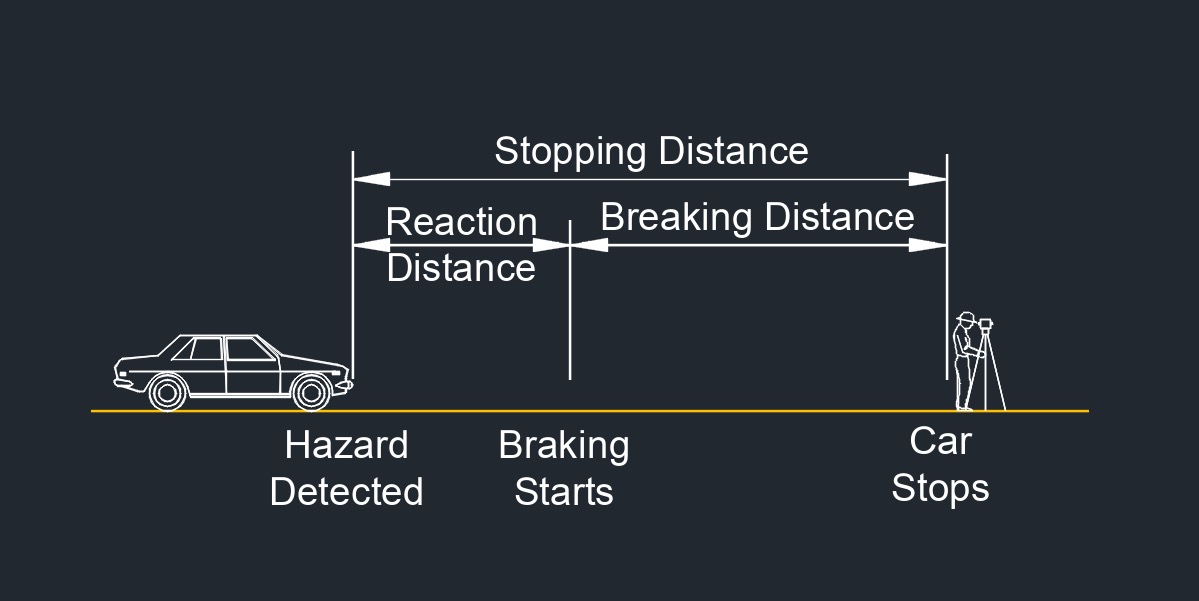Stopping Sight Distance
Stopping Sight Distance Formulas |
||
|
\( SSD \;=\; 1.47 \; V \cdot t + 1.075 \cdot \dfrac{ V^2 }{ a } \) \( SSD \;=\; 1.47 \cdot V \cdot t \cdot \dfrac{ 1.075 \cdot V^2 }{ a } \) \( SSD \;=\; \dfrac{ 1.47 \cdot V \cdot t + 1.075 \cdot V^2 }{ a }\) |
||
| Symbol | English | Metric |
| \( SSD \) = sight distance for stopping or passing | \( ft\) | \(m\) |
| \( V \) = design speed | \(ft\;/\;sec\) | \(m\;/\;s\) |
| \( t \) = brake reaction time | \(sec\) | \(s\) |
| \( a \) = deceleration rate | \(ft\;/\;sec^2\) | \(m\;/\;s^2\) |
Stopping sight distance, abbreviated as SSD, is the minimum distance required for a driver to perceive a hazard, react to it by applying the brakes, and bring their vehicle to a complete stop without colliding with the hazard. In other words, it's the distance a driver needs to stop safely after they have recognized a dangerous situation ahead.

Stopping Sight Distance Takes into Account Several Factors
Perception Time - The time it takes for a driver to notice a hazard and decide to initiate braking.
Reaction Time - The time it takes for a driver to physically move their foot from the accelerator to the brake pedal.
Braking Distance - The distance the vehicle travels while slowing down and coming to a complete stop after the brakes are applied.
The perception distance is determined by the driver's speed, reaction time, and the time it takes for the brain to process visual information. The reaction distance is influenced by the driver's reaction time and the initial speed of the vehicle. The braking distance depends on the vehicle's deceleration rate, which can vary based on road conditions, tire grip, and other factors.
Transportation engineers use SSD to design roads, intersections, and other traffic infrastructure to ensure that drivers have enough space to react to hazards and come to a safe stop. This helps prevent accidents and ensures the safety of road users. Different design standards and guidelines provide specific values for stopping sight distance based on road types, speeds, and other relevant factors.
AASHTO Exhibit 3-1 Stopping Sight Distance
|
||||
| Design Speed |
Design Speed Distance |
Braking Distance on Level | Stopping Sight Distance | |
| Calculated | Design | |||
| 15 | 55.1 | 21.6 | 76.7 | 80 |
| 20 | 73..5 | 38.4 | 111.9 | 115 |
| 25 | 91.9 | 60.0 | 151.9 | 155 |
| 30 | 110.3 | 86.4 | 196.7 | 200 |
| 35 | 128.6 | 117.6 | 246.2 | 250 |
| 40 | 147.0 | 153.6 | 300.6 | 305 |
| 45 | 165.4 | 194.4 | 359.8 | 360 |
| 50 | 183.8 | 240.0 | 423.8 | 425 |
| 55 | 202.1 | 290.3 | 492.4 | 495 |
| 60 | 220.5 | 345.5 | 566.0 | 570 |
| 65 | 238.9 | 4.505 | 644.4 | 645 |
| 70 | 257.3 | 470.3 | 727.6 | 730 |
| 75 | 275.6 | 539.9 | 815.5 | 820 |
| 80 | 294.0 | 614.3 | 908.3 | 910 |

